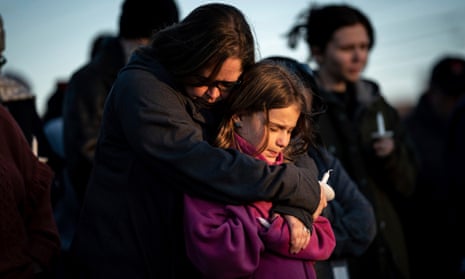
One mass killing every 6.53 days: US shootings are on a record pace
Despite the death toll, there is little indication of federal policy changes, but some states have tried to impose more gun control
The US is setting a record yearly pace for mass killings, with around one each week. According to a database tracking such events, the death toll from 17 mass killings in 111 days is 88. All were shot. Only 2009 saw as many such killings in the same period.
At a Nashville elementary school, three children and three adults were killed. In northern California, farm workers died over a workplace grudge. At a ballroom outside Los Angeles, dancers were massacred as they celebrated the Lunar New Year.
In the last week, four partygoers were killed and 32 injured at a Sweet 16 party in Dadeville, Alabama. In Bowdoin, Maine, a man just released from prison fatally shot four people including his parents before firing on motorists on an interstate highway.
“Nobody should be shocked,” said Fred Guttenberg, whose 14-year-old daughter Jaime was one of 17 people killed at a high school in Parkland, Florida, in 2018. “I visit my daughter in a cemetery. Outrage doesn’t begin to describe how I feel.”
The Parkland victims are among 2,842 people who have died in mass killings in the US since 2006, according to a database maintained by the Associated Press and USA Today in partnership with Northeastern University. The database counts killings involving four or more fatalities not including the perpetrator, the FBI standard.
Such events represent a fraction of fatal violence in the US annually. Yet mass killings are happening this year on average once every 6.53 days. Motives include murder-suicides and domestic violence; gang retaliation; school shootings and workplace vendettas. Yet barriers to change remain. A ban on semi-automatic rifles appears unlikely. The supreme court has called into question firearms restrictions.
In 2009, the year finished with 32 mass killings and 172 fatalities, close to the averages of 31.1 mass killings and 162 victims a year, according to data going back to 2006. But records have been set in the last decade. The data shows a high of 45 mass killings in 2019 and 230 killed in 2017. That year, 60 died when a gunman fired on a music festival on the Las Vegas Strip, the most fatalities from a modern US mass shooting.
“If somebody is determined to commit mass violence, they’re going to,” said Jaclyn Schildkraut, executive director of the Rockefeller Institute of Government’s Regional Gun Violence Research Consortium. “It’s our role as society to try and put up obstacles and barriers to make that more difficult.”
There is little indication of major policy changes at state or federal level but some states have tried to impose more gun control. Last week, the Michigan governor, Gretchen Whitmer, signed a law mandating criminal background checks to buy rifles and shotguns. On Wednesday, a ban on dozens of semi-automatic rifles cleared the Washington state legislature. In Tennessee, protesters demanded gun regulation after the Nashville school shooting.
At the federal level, Joe Biden last year signed a milestone gun violence bill, toughening background checks for the youngest gun buyers, keeping firearms from more domestic violence offenders and helping states use red flag laws that enable police to ask courts to take guns from people who show signs they could turn violent.
Mass killings remain statistically rare, perpetrated by a handful of people in a country of nearly 335 million.
“We shouldn’t necessarily expect that this – one mass killing every less than seven days – will continue,” said James Alan Fox, a Northeastern University criminologist. “Hopefully it won’t.”
after newsletter promotion
But experts and advocates decry the proliferation of guns, including record sales during the Covid pandemic.
“We have to know that this isn’t the way to live,” said John Feinblatt, president of Everytown for Gun Safety. “We don’t have to live this way. And we cannot live in a country with an agenda of guns everywhere, every place and every time.”
The National Rifle Association did not respond to a request for comment.
Jaime Guttenberg would be 19 now. Her father is a gun control activist.
“America shouldn’t be surprised by where we are today,” Fred Guttenberg said. “It’s all in the numbers. The numbers don’t lie. But we need to do something immediately to fix it.”

